Lady Elliot Island, Queensland, AustraliaContents of this Issue: Okeanos Aggressor II, Cocos Island, Costa Rica Older, Deeper, Longer and a Guinness Record Lady Elliot Island, Queensland, Australia Pulmonary Edema and Those Little Blue Pills The Great Barrier Reef; Dive it Now Are Hurricanes Damaging Your Dive Plans? A Close Encounter in the Baltic? Diving in Freezing Water? U.S. Navy Tests Flunk Some Regulators Were These Divers Electrocuted? Ear Infections and the ProEar Solution Is It Time To Hang Up Our Fins? Bahamas Conch Populations in Jeopardy Stuart Cove Guide Fired for Pummeling a Shark Are Some Snorkels and Snorkel Masks Death Traps? Editorial Office: Ben Davison Publisher and Editor Undercurrent 3020 Bridgeway, Suite 102 Sausalito, CA 94965 diving (what’s left of) the GBR from the October, 2017 issue of Undercurrent
Dear Fellow Diver,
And I had had plenty of misgivings. Most immediatez was Cyclone Debbie that had hit the Queensland coast in March. Debbie badly damaged Hamilton Island reefs. Lady Elliot is about 400 miles south of Hamilton (and just 50 miles south of the Tropic of Capricorn). It's the southernmost coral cay on the Great Barrier Reef (GBR) and surrounded by water 125 feet (38m) deep. On Lady Elliot, dive guide Phil Mitchell said the surge was from four to six meters. I had arrived on Lady Elliot in July and went snorkeling at Lighthouse. I was shocked at the massive amount of broken coral. As I went deeper, the damage was less pronounced. At 25-30 feet (8-9m), there was little damage. At a site called Turtle Beds, which is only about 15 feet (3m) deep, there was little damage to the huge field of staghorn coral. Fish populations seemed healthy -- large schools of small fish, including fusiliers, damsels, and chromis. And the colors were beautiful. The next day, my whale dive continued as it had begun -- mantas kept appearing at regular intervals -- a total of five. Along the way, I saw an 8-foot (2.5m) tawny nurse shark, a green turtle, and a large doubleheaded Maori wrasse. We were diving on the deeper, east side (most diving is done on the west side) at a site called Hiro's Cave. The corals were diverse, plentiful, and colorful -- both hard corals including cup, brain, plate, mushroom, finger, and wire, as well as soft corals like cauliflower, carnation, and gorgonian fans. And all of it completely undamaged and unbleached. So much for my misgivings about coral bleaching. After the first day, I quickly fell into the island's routine -- up early for the first dive at 7 A.M. Put on my rental 5mm suit (I had brought only my mask), assembled my tank, regulator and BCD and put them on the trailer. (Tanks are 12L and use A-clamp fittings.) After a five-minute drive to Lighthouse Beach, I donned my gear and walked down to the boat: A landing-craft barge with a drop-down gate in front. At high tide the boat comes very close, necessitating only a short walk; low tides, however, can sometimes occasion a long trek. Most of the dive sites are on the west side of the island with a maximum depth of about 75 feet (23m). Boat rides are five to 10 minutes. A 15-minute ride gets you to the other side of the island, where there are three deeper and spectacular sites. The top of the reef is down about 50 feet (15m), with another 40- to 50-foot drop to the bottom. The most famous site -- the Blowhole -- is an L-shaped cave that you enter from the top of the reef; drop down about 25 feet (7m) into the cave, then swim out on the face of the wall. During the ride to the dive site, they briefed us on the boat and the dive site. Although you are put into buddy groups, dive guides stress that they are your primary buddy and you should take your cues from them. If you do well with your air and your buddy doesn't, your buddy will be sent to the surface and you won't. Back on the boat, divers record their depth and bottom time and note the time of their safety stop. (The nearest hyperbaric facilities are in Brisbane, 250 miles south -- a journey that would take at least two airplane rides.)
In winter, the humpbacks arrive. If you're on your porch watching the tide fill the lagoon or at the outdoor bar enjoying a beer, you'll likely see them, blowing, breaching, fluke slapping, and spy hopping. This was the only time I saw one underwater, though I often heard their songs. Of all its creatures, Lady Elliot Island is best known for its reef mantas (Manta alfredi), which have wingspans over 15 feet (4.5m). In a study done from 1982 to 2012, 636 individuals were identified at Lady Elliot; of these, over 60 percent were sighted at least twice. One particular manta was sighted 11 times. If you send in your Lady Elliott manta photo to Project Manta and it's a unique animal not in their database already, you get to name it. Lady Elliot Island is both a National Park and Marine National Park; because it was designated a GBR Green Zone in 2005, it has the highest level of protection for the 1200 species that live on its land and in its waters. Today, fish here seem unusually relaxed. A first-time visitor to Lady Elliot remarked to me how unafraid of people the fish were; she had been going to Heron Island (about a hundred miles north) for 20 years and said you couldn't get close to fish there. But at Lady Elliot, fish are always swimming up to me or I to them. On one dive about 50 spotted eagle rays put on a show, swimming in formation and coming in close. A different sort of relaxation had apparently overcome the six turtles I saw on a dive at Turtle Beds -- they appeared to be asleep. I swam through a large school (300+ fish) of big-eyed trevallies. Later that dive, as I watched five large barracuda hanging near me, a large fish I didn't recognize came toward me and began flashing different colors. It had dozens of small but very pointed sharp teeth. Kate, my dive leader, waved frantically at me, so I backed off. On the surface, she told me it was a Spanish mackerel, a species that was sometimes aggressive, and that I was wise to retreat.
My last misgiving about Lady Elliot concerned its development, since the island is very small. The first time I visited, it could accommodate 70 visitors in about 20 units. Assistant manager Barry said that maximum capacity was now 150 people, who stay in a wide range of units. At the bottom are the "eco cabins," safari-style tents with two sets of single bunk beds. They have electricity, but guests use a shared block that has toilets, sinks, and showers. Next are the one- or two-bedroom garden units with private baths and porches. The reef units are similar, but face the lagoon. I have always stayed in the "island suites," two-bedroom units with private bath, small living room and kitchen area, and a lagoon-facing porch. They have air-conditioning, but I've never had a reason to turn it on, even in December, the Australian summer. Over the years, the view of the lagoon from these rooms has been compromised -- the octopus bushes in front have grown to a height of about eight feet; the resort is loath to trim them because red-tailed tropic birds nest beneath. (During my stay, the bird in front of my unit hatched her single egg.) I have to applaud when the resort puts the welfare of the bird over the view of the human. Lady Elliot claims that by 2020 it will be completely sustainable; a hybrid solar power station has cut the daily use of diesel fuel by 100 gallons. A reverse osmosis desalination system converts seawater to fresh water. Treated wastewater is used for irrigation. Food waste is composted, and other waste is removed by barge to treatment plants on the mainland. More than 4,000 trees have been planted.
Dinners always feature a cold salad bar and lots of hot options. On my first night, these included a chicken dish, fried fish, and roasted pork belly. There was a savory tart for vegetarians. During the rest of the week, hot options included grilled steaks and sausages, pork curry, barbequed brisket, and several different chicken dishes, most of which were tasty and filling. There's a dessert buffet, too (but again, more like comfort food than foodie food). For lunch, many people opt for the buffet at $21 a pop, but for me, the best meal of the day is at the bar overlooking the lagoon -- excellent hot steak sandwiches, burgers, fish, and chips -- at better prices.
But Gordon and Scott had sounded a little bit like her after their first day, and they felt that Lady Elliot's rules were heavy-handed. I told them that I had once felt the same way. There are only two dives a day -- morning at 7 A.M. and afternoon at 1 P.M. You are responsible for carrying your gear and rinsing it after dives. You are not allowed to dive on your own. Daily dive numbers were between 14 and 18, but divers are broken into smaller groups, the largest to which I was assigned had eight divers plus the leader. Little attention is paid to experience; after a dive on The Blowhole, I learned that the young English diver I had been paired with had just completed his third open water dive -- after having been certified in a quarry in Northern England a couple of months earlier. Regardless, the diving on Lady Elliot is very, very good, and the place itself has a way of making you slow down and relax. You accept the limitations. Perhaps even embrace them. It was clear to me over those beers that Gordon and Scott had had a great time at Lady Elliot. As I say this, though, I know that the island won't work for everybody, for it is not valet diving, nor is the food gourmet or the accommodations luxurious. But if you want to see the underwater splendors of the Great Barrier Reef before it's too late, Lady Elliot is one of your best options. -- DTV Our Undercover Diver's Bio: I came to diving relatively late -- in my forties -- and Lady Elliot was my first destination post-certification. Since then, I've been diving all over the world -- from South Africa's Sardine Run to Scotland's Scapa Flow.
|

I want to get all the stories! Tell me how I can become an Undercurrent Online Member and get online access to all the articles of Undercurrent as well as thousands of first hand reports on dive operations world-wide
| Home | Online Members Area | My Account |
Login
|
Join
|
| Travel Index |
Dive Resort & Liveaboard Reviews
|
Featured Reports
|
Recent
Issues
|
Back Issues
|
|
Dive Gear
Index
|
Health/Safety Index
|
Environment & Misc.
Index
|
Seasonal Planner
|
Blogs
|
Free Articles
|
Book Picks
|
News
|
|
Special Offers
|
RSS
|
FAQ
|
About Us
|
Contact Us
|
Links
|
3020 Bridgeway, Ste 102, Sausalito, Ca 94965
All rights reserved.

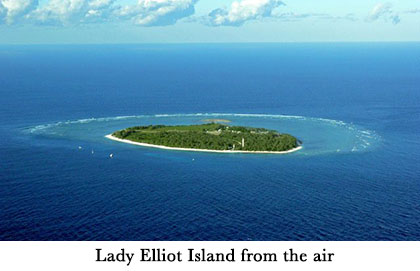 On my first dive off Lady Elliot Island, we were briefed that a strong current was running so we should use the line for our descent. I had barely started down when a manta that was 10 feet (3m) across swam slowly by. As I watched it, our dive leader, Phil, rocketed off toward the deeper water. I didn't know what was up, but knew it must be good, so I took off after him. In outstanding visibility, a humpback whale materialized, moving slowly toward the surface as we approached. I got within 30 feet of it before it moved back into the deep. I checked my computer -- only three minutes into the first dive. Any misgivings I had
had about returning to Lady Elliot Island had
vanished.
On my first dive off Lady Elliot Island, we were briefed that a strong current was running so we should use the line for our descent. I had barely started down when a manta that was 10 feet (3m) across swam slowly by. As I watched it, our dive leader, Phil, rocketed off toward the deeper water. I didn't know what was up, but knew it must be good, so I took off after him. In outstanding visibility, a humpback whale materialized, moving slowly toward the surface as we approached. I got within 30 feet of it before it moved back into the deep. I checked my computer -- only three minutes into the first dive. Any misgivings I had
had about returning to Lady Elliot Island had
vanished. 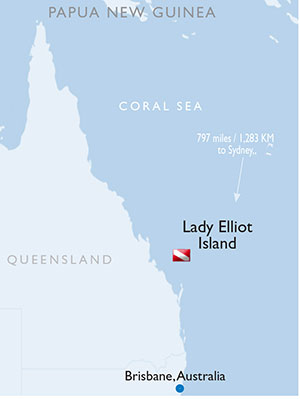 This was my fifth trip to Lady Elliot Island over 20 years. That first trip
got me hooked. I saw mantas, wobbegongs, green turtles, a big potato cod, and a
huge Queensland groper. On my return visits, I've had manta sightings every time
and shark sightings as well (in addition to the wobbegongs and tawny nurse sharks
that I've logged most visits, I've seen lots of leopard sharks, black-tipped reef
sharks, grey reef sharks, silvertips, and a bronze whaler). Besides the mantas,
there are a variety of rays -- I've seen cowtail rays, blue-spotted stingrays,
bull rays (the species that got Steve Irwin), eagle rays, and white-spotted shovelnose
rays. And not only are there lots of green turtles, but also the occasional
hawksbill or loggerhead. I've also seen both olive and black sea snakes.
This was my fifth trip to Lady Elliot Island over 20 years. That first trip
got me hooked. I saw mantas, wobbegongs, green turtles, a big potato cod, and a
huge Queensland groper. On my return visits, I've had manta sightings every time
and shark sightings as well (in addition to the wobbegongs and tawny nurse sharks
that I've logged most visits, I've seen lots of leopard sharks, black-tipped reef
sharks, grey reef sharks, silvertips, and a bronze whaler). Besides the mantas,
there are a variety of rays -- I've seen cowtail rays, blue-spotted stingrays,
bull rays (the species that got Steve Irwin), eagle rays, and white-spotted shovelnose
rays. And not only are there lots of green turtles, but also the occasional
hawksbill or loggerhead. I've also seen both olive and black sea snakes.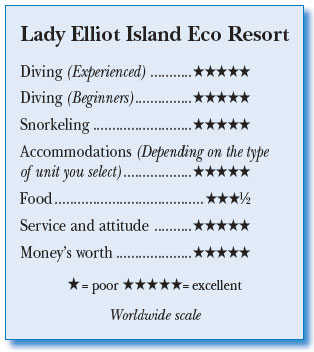 Some species aren't just relaxed, but also big. I saw huge Maori wrasse twice, estuary and potato cod, and several very big Queensland groupers, including one I'd estimate weighed over 400 pounds. Dive leader Phil pointed out a coral trout that I initially mistook for grouper because of its size. He told me that some species "are bigger than they are listed in the field guides." I'm a bit of a fish geek, but I couldn't keep up with the number of species I saw. Over a dozen kinds of butterfly fish, both familiar and new, lots of wrasses and parrotfish, and at least a half dozen kinds of angelfish, which are among the most beautiful fish there.
Some species aren't just relaxed, but also big. I saw huge Maori wrasse twice, estuary and potato cod, and several very big Queensland groupers, including one I'd estimate weighed over 400 pounds. Dive leader Phil pointed out a coral trout that I initially mistook for grouper because of its size. He told me that some species "are bigger than they are listed in the field guides." I'm a bit of a fish geek, but I couldn't keep up with the number of species I saw. Over a dozen kinds of butterfly fish, both familiar and new, lots of wrasses and parrotfish, and at least a half dozen kinds of angelfish, which are among the most beautiful fish there.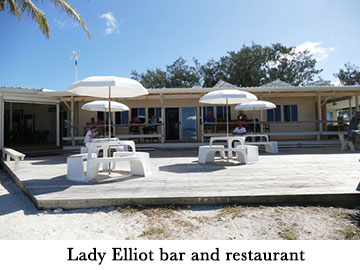 Breakfasts and dinners are part of the package. The hot breakfast is very British -- eggs, bacon, grilled tomatoes, mushrooms, baked beans, tater tots (called "potato gems" in Australia), bread and pastry items, cereal, and some fresh fruit and yogurt. Although breakfast doesn't officially begin until 7:00 (the time at which you report for the first dive), divers are welcome to eat with the staff starting at 6:30. If you don't want to eat that early, you can make up a plate of food and the cook will reheat it when you return from the dive. Australians know how to make good coffee, and it was worth the $3 to have my morning latte.
Breakfasts and dinners are part of the package. The hot breakfast is very British -- eggs, bacon, grilled tomatoes, mushrooms, baked beans, tater tots (called "potato gems" in Australia), bread and pastry items, cereal, and some fresh fruit and yogurt. Although breakfast doesn't officially begin until 7:00 (the time at which you report for the first dive), divers are welcome to eat with the staff starting at 6:30. If you don't want to eat that early, you can make up a plate of food and the cook will reheat it when you return from the dive. Australians know how to make good coffee, and it was worth the $3 to have my morning latte.
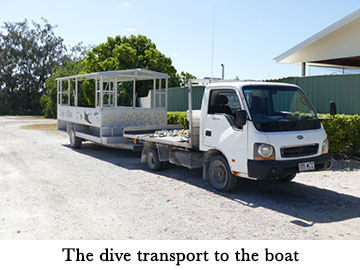 On my last evening, I was having a beer with Gordon and Scott, a couple of Aussies, and we were laughing about a woman who had been with us that afternoon. She had been complaining about all of the regulations. Use the descent line. Stay with the group. Come up after an hour. And at the end of the first dive, she even complained that there was "too much sand" at the dive site. She was not happy.
On my last evening, I was having a beer with Gordon and Scott, a couple of Aussies, and we were laughing about a woman who had been with us that afternoon. She had been complaining about all of the regulations. Use the descent line. Stay with the group. Come up after an hour. And at the end of the first dive, she even complained that there was "too much sand" at the dive site. She was not happy. Divers Compass: Prices (which include breakfast and dinner) range from about $135/person (double occupancy) for an eco-cabin to $285/person for an island suite ... I paid $2,475 in advance for two people, which included accommodations (I took advantage of their "Pay 4/Stay 5" package), breakfasts and dinners, and the return flight from Bundaberg to Lady Elliot ... Eight dives, rentals, and incidentals (bar bill, espresso bill, and internet) added $850; it broke down to about $45/dive plus another $45/day for gear rental (the gear was good and included new Suunto computers). Nitrox is an additional fee.
Divers Compass: Prices (which include breakfast and dinner) range from about $135/person (double occupancy) for an eco-cabin to $285/person for an island suite ... I paid $2,475 in advance for two people, which included accommodations (I took advantage of their "Pay 4/Stay 5" package), breakfasts and dinners, and the return flight from Bundaberg to Lady Elliot ... Eight dives, rentals, and incidentals (bar bill, espresso bill, and internet) added $850; it broke down to about $45/dive plus another $45/day for gear rental (the gear was good and included new Suunto computers). Nitrox is an additional fee. 